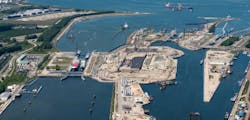California Gas Perspective: State needs NG Infrastructure upgrade to complement Renewables
By Raymond Kim, Northern Arizona University
and Christopher S. Tang, UCLA
There was a sigh of relief when the inflation rate dropped from 9.1 percent in June 2022 to 6 percent in February.
But Californians are shocked by their sky-high gas bills this winter. To ensure supply and price stability for Californians, there is a need to invest in storage capacity, pipelines, and transportation infrastructure for natural gas.
During the unexpected recent cold weather in California, wholesale prices for natural gas went to the roof: 300% higher in December than in January 2022. By February, residents’ monthly energy bills approached $800 even as natural gas prices dropped to pandemic-era lows. In March, some angry residents threatened not to pay extra.
To make things worse, Southern California Gas Co. has proposed to increase rates in January 2024 by 13.2% to upgrade its infrastructure while trying to grow its renewable energy options. In the wake of skyrocketing gas bills in this winter, there is a new concern over higher electricity bills this summer.
On the surface, one can blame the soaring price of natural gas in California on the unexpected demand due to cold weather. Beneath the surface, it is the poor energy policy in California that is exposing us to supply risk and price risk.
For years, California’s politicians and regulators pushed for renewable energy and discouraged significant investment in storage and pipeline capacity.
Since 2006, California’s natural gas production has fallen by 60%, producing only 6.7% of California’s natural gas consumption in 2021. Natural gas is also the primary source of California’s electricity, and Californians pay 61% more per kilowatt hour than the US average while importing 33% of its electricity from other states, the highest percentage in the US.
Currently, California is unable to increase gas production or gas storage. For example, since the gas leak incident at the Aliso Canyon natural gas storage facility in 2015, there were concerns over safety and politicians have called for its closure. The natural gas storage in December in the Pacific region was 30% below the five-year average.
Without ample gas storage facilities, gas companies in California have limited flexibility to purchase and store natural gas from April to October when gas prices are low.
Indeed, this cold, rainy winter in California has crippled its short-term solar generation, and California’s natural gas supply chain could not meet this surge in demand. Due to a lack of investments in storage and pipeline capacity, California relies on interstate pipeline imports for more than 95% of its supply from Arizona, New Mexico, and Texas.
Depending on other states is risky.
A pipeline that exploded in Arizona in 2021 reduced the flow of gas to California in 2022. Also, when the spot price of natural gas in west Texas fell below zero in October 2022, the producer reduced production to stay afloat, lowering the amount of gas flowing west.
With decreased supply and higher demand for gas this winter in California, power companies paid $54 per million BTUs, compared to about $7 in the national benchmark price.
On top of that, the reduction in the flow of gas from other states through different pipelines created a perfect storm, costing Californians $4 billion in additional costs in December and January.
Currently, Southern California Gas company offers $10 million in funding to help customers to pay their high gas bills as a stopgap measure, but there is a need for a long-term solution in California.
Due to climate change, it is risky and costly for California to be overly dependent on renewable energy. To mitigate the risk of a drastic transition from fossil fuels to clean energy, California needs to invest in new storage and pipeline capacity as a backup.
Unlike oil, which can be moved around in its natural state, gas must be pressurized and transported through a complex and expensive network of pipelines. Without investment to maintain and develop storage and pipelines in California as a mitigation plan, the state government is creating shortages and price risk unnecessarily.
Before a reliable and sustainable renewable energy generation process is proven, California should allocate some of its $45.5 billion from the new federal infrastructure fund to developing a safe and efficient system to produce, store, and transport natural gas.
We make three suggestions to ensure resilient supply and stable natural gas prices for Californians.
First, California can learn from Germany about developing safe and efficient pipelines in the north to transport liquified natural gas as a long-term alternative to getting supply from Qatar and elsewhere instead of Russia.
Second, in addition to pipelines, transporting liquified natural gas by rail is an efficient way to provide access when no pipelines are in the area. Besides access, rail transportation offers more flexibility than pipelines in terms of destination. Also, rail transportation can provide additional capacity during times of high demand when existing pipelines may be at capacity.
Third, public safety concerns were raised in 2020 about transporting liquified natural gas by rail. These concerns are heightened after the recent major train derailment in Ohio in February. As such, there is a need to improve the rail infrastructure, container safety, and safety protocol for transporting gas by rail.
Before we are sure that renewable energy is abundant and reliable, California still needs natural gas as a reliable source of energy.
About the authors: Raymond Kim is an Assistant Professor of Finance at the W.A. Franke College of Business at Northern Arizona University. Christopher S. Tang is a distinguished professor at the UCLA Anderson School of Management.





